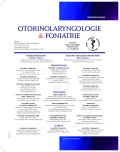Posterior Glottic Stenosis
Authors:
J. Schneiderová 1; Karol Zeleník 1,2
; Pavel Komínek 1,2
Authors place of work:
Klinika otorinolaryngologie a chirurgie hlavy a krku, Fakultní nemocnice Ostrava
1; Katedra kraniofaciálních oborů, Lékařská fakulta, Ostravská univerzita v Ostravě
2
Published in the journal:
Otorinolaryngol Foniatr, 67, 2018, No. 2, pp. 67-70.
Category:
Kazuistika
Summary
We present a case of a 75- year old man with posterior glottic stenosis and difficult breathing. It is necessary to differentiate posterior glottic stenosis from bilateral vocal cord paralysis. Posterior glottic stenosis with arytenoid fixation is an uncommon complication of laryngeal injury. Through etiologies vary, the most common is prolonged intubation. Injury of posterior commissure may lead to scar and fixation of one or both arytenoid cartilages in an adducted position. Bilateral fixation commonly causes dyspnea, dysphonia and tracheostomy dependence. Surgical treatment techniques for posterior glottic stenosis includes simple scar transection, suture lateralization according to Ejnell or Lichtenberger, posterior cordectomy and subtotal or total arytenoidectomy and posterior cricoid split using cartilage graft (usually form rib).
Keywords:
dyspnea, posterior glottic stenosis, arytenoidectomy, suture lateralization by Ejnell method, cordotomy
Zdroje
1. Ejnell, H., Mansson, I., Hallén, O. et al.: A simple operation for bilateral vocal cord paralysis. Laryngoscope, 94, 1984, 7, s. 954-958.
2. Gallivan, G. J.: Bilateral vocal fold posterior glottic/subglottic stenotic web resected with contact tip Nd-YAG laser. Journal of Voice, 16, 2002, 3, s. 415-421.
3. Hatcher, J. L., Dao, A. M., Simpson, C. B.: Voice outcomes after endoscopic treatment of laryngotracheal stenosis. Annals of Otology, Rhinology and Laryngology, 124, 2015, 3, s. 235-239.
4. Hiller, A. T., Karatayli-Ozgursoy, S., Samad, I. et al.: Predictors of posterior glottic stenosis: a multi-institutional case-control study. Annals of Otology, Rhinology and Laryngology, 125, 2016, 3, s. 257-263.
5. Hoasjoe, K., Franclin, S., Aarstad, R. et al.: Posterior glottic stenosis mechanism and surgical management. Laryngoscope, 107, 1997, 5, s. 675-679.
6. Howard, N., Shiba, T., Pesce, J. et al.: Photodocumentation of the development of type I posterior glottic stenosis after intubation injury. Casereports in Surgery, 2015, s. 3.
7. Matsushima, K., Matsuura, K., Takeda, T. et al.: Transcricothyroid endoscopic subglottic surgery for posterior glottic stenosis: A case report. Journal of Voice, 31, 2017, 5, s. 634-637.
8. Rovo, L., Venczel, K., Torkos, A. et al.: Endoscopic arytenoid lateropexy for isolated posterior glottic stenosis. Laryngoscope, 118, 2008, 9, s. 1550-1555.
9. Sztano, B., Szakacs, L., Madani, S. et al.: Comparison of endoscopic techniques designed for posterior glottic stenosis – a cadaver morphometric study. Laryngoscope, 124, 2014, 4, s. 705-710.
Štítky
Audiologie a foniatrie Dětská otorinolaryngologie OtorinolaryngologieČlánek vyšel v časopise
Otorinolaryngologie a foniatrie

2018 Číslo 2
- Isoprinosin je bezpečný a účinný v léčbě pacientů s akutní respirační virovou infekcí
- Fexofenadin – nesedativní a imunomodulační antihistaminikum v léčbě alergických projevů
- Pacienti s infekcemi HPV a EBV a možnosti léčebné intervence pomocí inosin pranobexu
- Inosin pranobex v léčbě HPV infekcí děložního čípku
- Doc. Jiří Kubeš: Zásadní přínos protonové terapie spočívá v ochraně zdravých tkání
Nejčtenější v tomto čísle
- Cysty krčních mízovodů
- Uzávěr perforací nosního septa pomocí individuálně vyráběných obturátorů - první zkušenosti
- Refluxná záťaž v hypofaryngu podľa dvojkanálovej pH/Z nekoreluje s Reflux Finding Score u pacientov s laryngofaryngeálnym refluxom
- Zadní glotická stenóza
